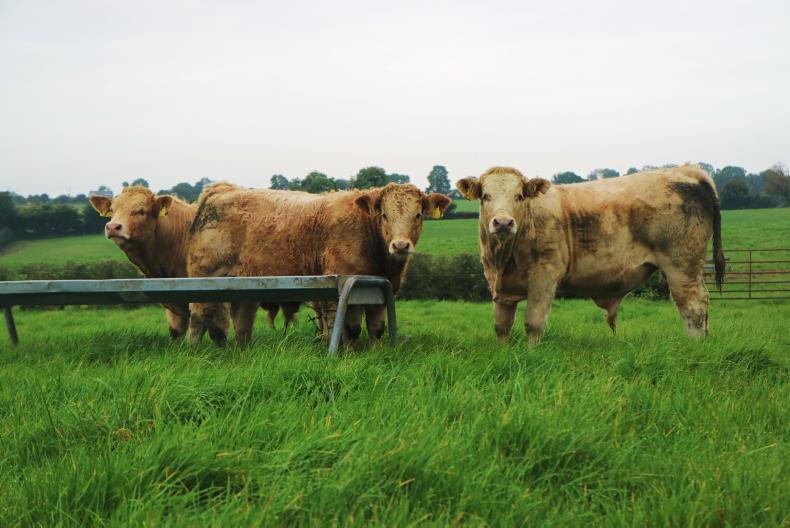If you intend to sell your weanlings or stores, you need to make adequate preparations so that they appear healthy and vigorous on sale day. It is important that the farmer who buys them will have a trouble-free outcome – returning customers are valuable in any business.
Bovine respiratory disease (BRD) is still the number one killer of adult cattle in Ireland and one of the greatest sources of worry for farmers buying or preparing weanlings at this time of year.
BRD in weanlings is has many contributing issues involving the animal, the environment and the various agents that cause lung infections (lungworm, viruses, bacteria and mycoplasmae). Though much emphasis is placed on the agents that cause BRD, it is important to realise that successful disease management will only result from a control programme that includes a variety of aspects.
The effects of viruses, bacteria and mycoplasmae can be minimised through the use of some management strategies in association with vaccination. Medication, using antibiotics, should only be used if no other viable option is available.
Fundamentally, control of losses will hinge on executing all the steps in a timely manner necessary to minimise risk.
1 Parasite control: Lungworm should always be eliminated by the use of an effective anthelmintic dose at housing. Consider also a fluke dose, though if your farm is not heavily infested this could be delayed until six to 10 weeks after housing, with another dose administered six weeks later. Seek advice from your vet to ensure the flukicide product you use is effective against early immature fluke. Rumen fluke control may also need to be considered on some farms, as I have encountered weanlings becoming ill after housing where a heavy infestation existed. Again, seek veterinary advice on your risk profile – it is not advisable to rely on faecal testing alone to guide the need for treatment.
2 Weaning: All farmers have their own weaning process, varying from abrupt total weaning to staged partial removal of cows. Creep access to new pasture facilitates reduction of the calf-cow bond, lowering weaning-related stress. Aside from the standard advice of avoiding dehorning or castration at weaning time, equally vaccinations should be administered at least two weeks either side of weaning as the stress involved may interfere with vaccine effectiveness. Ensuring animals are consuming at least a kg of meal prior to weaning means the production hit of milk removal is lessened. Next week’s articles will focus in detail on strategies for weaning.
3 Vaccination: Vaccines against BRD fall into two broad categories – vaccines against upper airway disease (IBR) and those that tackle pneumonia (lung disease). Within each group you may use either live or inactivated (dead vaccines). Dead vaccines are administered by injection and, as a general rule, are slow at inducing immunity. Thus it is necessary to organise vaccination well ahead of housing. Two injections are invariably required spaced approximately four weeks apart to give strong and lasting immunity.
So, which BRD-causal agents do you need to consider in a vaccination regime? Three-quarters of Irish herds are infected with IBR, a very high proportion have PI3 and respiratory syncytial virus (RSV), nearly all have Mannheimia haemolytica and Pasteurella multocida and possibly up to one-third of herds have Mycoplasma. Unfortunately, little is known about the prevalence of Histophilus somni in Ireland though as a mortality causal agent it ranks similar to IBR in official reports.
Upper airway disease, most commonly IBR (infectious bovine rhinotracheitis), is a serious clinical disease which can give rise to coughing, runny eyes/nose and even death when pneumonia arises as a complication, again most commonly from bacterial infection alongside.
Weight loss is significant and it tends to become endemic in large units. IBR vies with RSV as the number one cause of viral respiratory disease in weanlings. RSV is probably the most common cause of post-housing weanling pneumonia. Classically it causes difficulty in breathing, frothing at the mouth and death. It is often complicated by bacteria, especially Mannheimia haemolytica.
Parainfluenza virus causes fever, weight loss and mild pneumonia. Its biggest influence is that it makes animals more susceptible to other forms of pneumonia.
Live vaccines administered intranasally give more rapid onset of cover. Live vaccines are available against IBR and various vaccines are available (See table). Mannheimia haemolytica is a common cause of pneumonia in housed cattle due to a stress-related increase in this bacterium in the lungs or secondary to viral infection. If untreated, animals die in a few days. Mycoplasma is becoming more commonly diagnosed on Irish farms and it may be more common than official diagnostic rates suggest. It causes mild coughing, ill-thrift and death if untreated. There is no vaccine for this latter agent and control depends on improving ventilation and stocking rates and treating with a mycoplasma-effecive antibiotic product.
4 Medication: Long-acting novel antibiotic injections have been licensed over the past number of years for both treatment and prevention of pneumonia. Antibiotics, however, are really only useful in controlling losses in the early stage of a potential outbreak or as a preventative when animals arrive after extended transport. Their usage should be minimised as indiscriminate use encourages the development of resistance and increases the risk of residue violations. Any impending outbreak of pneumonia should involve immediate consultation with your vet as he/she is best placed to advise you on all of the treatment options available.
Conclusion
Losses associated with a mild outbreak of BRD have been estimated to cost €50-€150/head in production losses and medication expenses, not to mention the subsequent subclinical losses. Full vaccination at €15-17/head certainly pays for itself many times over in the face of estimates like this. Management practices in conjunction with vaccination will assist in minimising losses. Antibiotics to control disease should really only be used as a last resort. Always consult your vet early and frequently for best advice on prevention and treatment.






 This is a subscriber-only article
This is a subscriber-only article












SHARING OPTIONS: